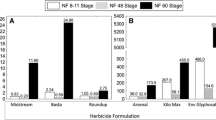Abstract
The development of Xenopus laevis (African clawed frog) embryos exposed to the pesticide Guthion® (technical grade) and Guthion® 2S (commercial formulation) was evaluated in modified Frog Embryo Teratogenesis Assay—Xenopus (FETAX) tests. The embryos were exposed to five or six increasing concentrations of pesticide in 10- and 100-ml exposure volumes of test solution for 96 h. Embryos exposed in 10-ml volumes of Guthion exhibited increased mortality, increased deformation, and decreased size as compared to those exposed in 100-ml volumes. LC50s for embryos exposed in the 10-ml Guthion tests ranged from 6.1 to 6.3 mg/L as compared to 10.6 to 11.9 mg/L for those in the 100-ml tests. The percentage of deformities at 3 mg/L Guthion in test survivors in 10-ml tests ranged from 73 to 89%, while in the 100-ml tests less than 2% were deformed at the same concentration. Mean control embryo lengths at test completion were 8.2 and 10.6 mm, respectively, for 10- and 100-ml tests. The LC50 for embryos in 100 ml Guthion 2S was 1.6 mg/L active ingredient, indicating a much greater toxicity of the commercial formulation. NOAEL (No Observed Adverse Effect Level) values for Guthion and Guthion 2S ranged from 0.48 to 7.96 mg/L, depending upon basis (length, deformity, mortality) and pesticide formulation, and were many times greater than the existing water quality criterion of 0.01 μg/L.
Similar content being viewed by others
References
American Society for Testing and Materials (1991) Standard guide for conducting the frog embryo teratogenesis assay—Xenopus (Fetax). ASTM E1439-91. Philadelphia, PA
Anderson RA, Aaraas I, Gaare G, Fonnum F (1977) Inhibition of acetylcholinesterase from different species by organophosphorus compounds and methylsulphonylfluoride. Gen Pharmacol 8:331–334
Bantle JA, Fort DJ, James BL (1989) Identification of developmental toxicants using the frog embryo teratogenesis assay—Xenopus (FETAX). Hydrobiologia 188/189:577–585
Computer Sciences Corporation (1988) Users' guide for a computer program for Dunnett's procedure in the analysis of data from short term chronic toxicity tests with aquatic organisms. U.S. Environmental Protection Agency, Cincinnati OH
Cooke AS (1979) The influence of rearing density on the subsequent response to DDT dosing for tadpoles of the frog Rana temporaria. Bull Environ Toxicol 21:837–841
de Llamas MC, de Castro AC, Pechen de D'Angelo AM (1985) Cholinesterase activities in developing amphibian embryos following exposure to the insecticides dieldrin and malathion. Arch Environ Contam Toxicol 14:161–166
Hall RJ, Kolbe E (1980) Bioconcentration of organophosphorus pesticides to hazardous levels by amphibians. J Toxicol Environ Health 6:853–860
Hamilton MA, Russo RC, Thurston RV (1977) Trimmed Spearman-Karber method for estimating median lethal concentrations in toxicity bioassays. Environ Sci Technol 11:714–719. Correction 12:417 (1978)
Henderson JE, Payton GR, Glaze WH (1977) A convenient liquid-liquid extraction method for the determination of halomethanes in water at the parts-per-billion level. In: Keith LH (ed) Identification and analysis of organic pollutants in water. Ann Arbor Science Publ, Ann Arbor, MI, Chap 7, pp 105–111
Linder G, Barbitta J, Kwaiser T (1990) Short-term amphibian toxicity tests and paraquat toxicity assessment. In: Landis WG, van der Schalie WH (eds) Aquatic toxicology and risk assessment: Thirteenth volume, ASTM STP 1096. American Society for Testing and Materials, Philadelphia, pp 189–198
Mayer FL, Ellersieck MR (1986) Manual of acute toxicity: Interpretation and data base for 410 chemicals and 66 species of freshwater animals. U.S. Fish Wildl Serv Resource Publ 160, Washington, DC
Mulla MS, Isaak LW, Axelrod H (1963) Field studies on the effects of insecticides on some aquatic wildlife species. J Econ Entomol 56:184–188
New DAT (1966) The culture of vertebrate embryos. Academic Press, NY
Sanders HO (1970) Pesticide toxicities to tadpoles of the Western Chorus Frog Pseudacris triseriata and Fowler's Toad Bufo woodhousii fowleri. Copeia 1970:246–251
Schuytema GS, Nebeker AV, Griffis WL, Wilson KN (1991) Teratogenesis, toxicity and bioconcentration in frogs exposed to dieldrin. Arch Environ Contam Toxicol 21:332–350
Schuytema GS, Nebeker AV, Peterson JA, Griffis WL (1993) Effects of pentachlorophenol-contaminated food organisms on toxicity and bioaccumulation in the frog Xenopus laevis. Arch Environ Contam Toxicol 24:359–364
Sklar FH (1985) Crustacea (Procambarus clarkii) response to an organophosphate diet. Environ Pollut (Ser A) 39:131–140
U.S. Environmental Protection Agency (1979) Methods for chemical analysis of water and wastes. EPA-600/4–79–020. Environmental Monitoring and Support Laboratory, Cincinnati, OH
— (1986a) Quality criteria for water 1986, EPA 440/5–86–001. Office of Water Regulations and Standards, Washington, DC
— (1986b) Pesticide fact sheet number 100. Azinphosmethyl (Guthion). PB87–116478. Office of Pesticide and Toxic Substances, Washington, DC
U.S. Department of Agriculture (1992a) Agricultural chemical usage 1991. Field crops summary. Ag Ch 1(92) March. National Agricultural Statistics Service, Economic Research Service, Washington, DC
— (1992b) Agricultural chemical usage 1991. Fruits and nuts summary. Ag Ch 1(92) June. National Agricultural Statistics Service, Economic Research Service, Washington, DC
Williams B, Marcy S, Gerould S (1989) Water quality to protect wildlife resources. EPA 600/3–89–067. U.S. Environmental Protection Agency, Corvallis Environmental Research Laboratory, Corvallis, OR
Author information
Authors and Affiliations
Rights and permissions
About this article
Cite this article
Schuytema, G.S., Nebeker, A.V. & Griffis, W.L. Toxicity of Guthion® and Guthion® 2S to Xenopus laevis embryos. Arch. Environ. Contam. Toxicol. 27, 250–255 (1994). https://doi.org/10.1007/BF00214270
Received:
Revised:
Issue Date:
DOI: https://doi.org/10.1007/BF00214270




